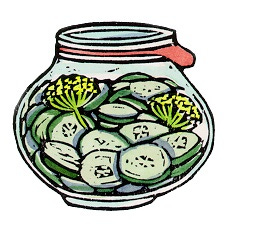Welcome to the Art of Growing Food newsletter. Each week, you’ll find artful growing tips and ideas for fresh eating from your kitchen garden. You are receiving this newsletter because you are a free subscriber. Thank you!

Hello Everyone,
Cucumbers are taking over the garden right now. Big, small, and in-between, the plants require daily harvest to keep the fruits perfectly sized for making pickles. A pickling cucumber, unlike the eating cucumber, is at its prime when only a stubby 4 inches long. With a dry and relatively seedless interior, eating it fresh would make your mouth pucker. They require constant vigilance to harvest at just the right size to make perfect pickles.
Making pickles is a summer ritual, yet with so many recipes to choose from, often the most difficult question is which recipe to use?
Pickles can be made from any garden vegetable, yet I prefer to use cucumbers. To make my recipe for Bread and Butter Pickles, begin the process of fermentation by slicing and salting to release excess water, then cover with cold water to sit overnight. In the morning, rinse under more cold water, while preparing a brine with apple cider vinegar, salt, and spices. Salt controls the fermentation process, while vinegar is added as a preservative, and fresh or dry seasoning such as fresh dill, mustard seeds, and garlic imparts flavor. Cucumbers on their own are pretty tasteless.
Sweet Bread and Butter Pickles
I’ve been making pickles since 1990 when I stocked my Vermont farmstand with jams and pickles for customers to buy. It was a late-night activity that I did after the kids went to bed. At midnight, I fell asleep listening for the jar lids to snap as they cooled, satisfied that they had been properly hot water bathed. During these years, I tried a cornucopia of recipes, from dill spears to whole pickles, to fresh refrigerator cornichons, yet it was always the Bread and Butter Pickle that was everyone’s favorite. It is that perfect combination of sweet and sour, small enough to spear with a fork and a little too easy to stand at the kitchen sink eating from the jar.
Although not quite as simple a fermentation process as making sauerkraut or kimchi, fermentation is still what makes any pickle both a healthy snack and relatively safe to preserve.
Cornichons are Cool
Another quick way to make pickles is to make a refrigerator pickle, a method embraced by those who are a little fearful of the pickling process. It’s a smart way to make a quick pickle for gardeners who have a bumper crop of cucumbers, and not much time to stand stirring over a hot stove. It’s also a win-win for gardeners and pickle lovers, as the wait time is reduced to as little as two weeks from garden to jar.
A classic example of a refrigerator pickle is known as a cornichon, often seen as a condiment featured on a French charcuterie plate or Italian antipasto. It is not just a baby cucumber, because it is made from a specific very small, specialized European cucumber variety known as a gherkin.
From the John Scheepers Kitchen Garden Seed catalog:
Cornichon is French for tiny, crisp pickles made from gherkin Cucumbers. A glass of Sancerre, fresh baguettes, pâté and our tart cornichons will transport your picnic to the French countryside! A French heirloom variety dating back to the late 1800s, Parisienne Cornichon de Bourbonne was used extensively in France as the premier pickling Cornichon.
It is grown the same way as a standard cucumber, yet harvested at just 2 inches long, incredibly labor-intensive at the growing end, yet easy on the pickling side. Once you’ve made the brine of white vinegar, tarragon, and garlic, the gardener can keep adding to the jar for an ever-ready treat of fresh, green pickles.
The Watermelon Pickle Story
Every summer, my mother bought the biggest watermelon she could find, and invited all the neighborhood kids to come over to eat it. We sat at the picnic table outside the kitchen door, with bowls full of watermelon wedges, talking about who could eat the most with seed spitting contests in between.
While this was certainly a good way to keep us busy and entertained, she had two rules: 1. Place all the rinds in a clean bowl. 2. Leave bits of the pink on the rind, instead of gnawing all the way down.
This was how we helped her to make watermelon pickles. It was a family recipe handed down for generations, and when we opened the jars at Thanksgiving, we remembered that August day eating the melons.
After everyone left, I’d watch her in the kitchen, the canning kettles rattling with jars, and her sharp knife cubing the rinds into one-inch pieces. These were simmering in brine, and after what seemed like days, but was only an afternoon, she had six jars of watermelon pickles cooling on the windowsill.
Food is full of memories. That’s why I am offering an online writing class starting in October, for cooks who love to write about food. How to Write a Family Cookbook is a six-part series, pre-recorded for you to watch at your leisure, with six live sessions with me to talk about food and your cookbook. I’ll be sharing more about this class in the coming week, but if you are interested in my free introductory class, click here and sign up.
Making pickles marks the end of summer, a bittersweet time of year when it’s time to harvest everything while also sitting back to enjoy the splendor.
From my kitchen garden to yours,
Ellen Ecker Ogden
Ellen Ecker Ogden is a food and garden writer and author of six books. Follow the year-round progress of her Vermont garden on Instagram or sign up for a writing or design workshop on her website.








